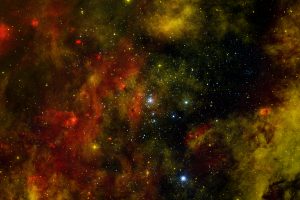X-rays from Cygnus. The paper: “X-ray spectral characterization of the young Cygnus OB2 population” of E. Flaccomio (INAF-OAPA) accepted for publication by ApJS

OB associations are objects of great importance, since they contain a rich population of OB stars. Despite their paucity, OB stars have a strong impact on the evolution of their parental clouds, nearby stars, and the whole Galaxy. For instance, their intense UV emission affects the evolution of the parental cloud and the star formation process in it, sometimes triggering the formation of new generations of stars. It also can affect the formation of planets in nearby stars.They also have strong stellar winds that can collide, producing shocks emitting energetic (more than 1 keV) X-ray photons. Besides, OB stars explode in supernovae in a few million years, enriching the interstellar medium of the chemical elements processed in their core.
The OB association Cygnus OB2 in the constellation of Cygnus, is the most massive association within 5000 light years from the Sun. With a stellar population of more than 10000 low mass stars about 3 million years old, and a few hundreds massive stars among which two O3 stars (about 60 times the mass of the Sun, the most massive stars known), CygOB2 is the best target to study the star formation process in presence of such a massive stellar population. This has motivated the Chandra Cygnus OB2 Legacy Project: an international project based on X-ray observations obtained with the NASA satellite Chandra, and led by astronomers at CfA (Center for Astrophysics, Cambridge, MA, USA). Several researchers from the INAF- Astronomical Observatory of Palermo are strongly involved in this project.
The astronomer Ettore Flaccomio of INAF – Astronomical Observatory of Palermo is part of the team of the project, with the task of analyzing the X-ray observations of Cygnus OB2 in order to derive the X-ray luminosity and coronal properties of the detected stars. Stellar X-ray emission, in fact, mainly come from the coronae, i.e. the stellar atmosphere with low density plasma at several million degrees. Coronal plasma properties and stellar X-ray luminosity can be derived by comparing the X-ray spectra with accurate models of the X-ray emission of coronal plasma. From this analysis, the authors have derived not only the stellar X-ray luminosity, but also the individual coronal plasma temperature and the hydrogen column in the interstellar medium absorbing stellar radiation. The authors have also estimated the chemical abundances in CygOB2 stars, finding that they are similar to those observed in other star forming regions. The paper “X-ray spectral characterization of the young Cygnus OB2 population” has been accepted by “The Astrophysical Journal Supplement” and it will be published in the special issue dedicated to the Chandra Cygnus OB2 Legacy Project.
The figure (link) shows a composite image with marked the nebular emission and the stars observed in optical and X-rays
Mario Giuseppe Guarcello ( follow mguarce)
